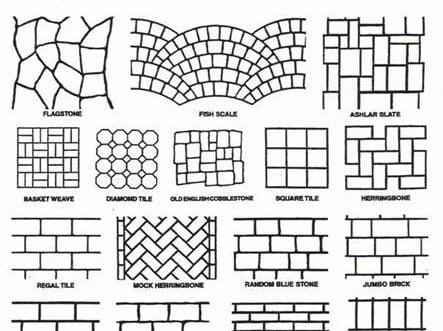- Concrete Stencils Home
- Paper or plastic The pros and cons of each
- Stock or custom concrete stencils: Which type fits your design needs?
- Adhesive or nonadhesive stencils: When to use each type
- Concrete stencil patterns: View some of the options
- How-To Tips for Using Stencils
- Step-by-step process of applying stencils
- Using microtopping and stencils to rejuvenate ugly concrete
- Related Information:
- Stenciling Concrete Floors
- "Floor Me" video series: Stencil design ideas and techniques
- Concrete logos and graphics: Creating images with concrete stencils
- Bob Harris' five favorite methods for creating graphics on floors
Stock or Custom Stencils?
Many stencil manufacturers offer a wide variety of off-the-shelf stencil designs to choose from. Your options run the gamut from running-bond or Herringbone brick, to cobblestone, flagstone or octagonal tile. For many projects, especially larger slabs using repeating patterns, a stock pattern will be the most practical and economical choice, since they are typically offered in large rolls or sheets.
If you want to personalize a project or do something truly unique, one of the big advantages of stencils is their ability to be customized to meet special design requirements. Stencil companies use computer-design software and computer-guided cutting machinery to create stencils that precisely replicate customer-supplied patterns, logos or other original artwork.
"We offer nearly a thousand standard decorative patterns, but about half of our business is custom," says Melanie Royals of Modello Designs, which sells adhesive vinyl masking patterns for concrete and other surfaces. Her staff of graphic artists can alter a standard Modello pattern to meet customer design preferences or create a custom Modello from scratch to replicate customer-supplied art-a service called "Design on Demand." They can work from line drawings, photos, monograms and logos. They can also adapt patterns from fabric, wallpaper or carpet samples. The pattern is scaleable as well, and can be sized to fit the exact dimensions of each project.
There are several companies that make custom stencils. They can create designs directly from just about any vector file format, including Illustrator, Coreldraw and Autocad. They can also work from non-vector digital art, including TIFF, JPEG and BMP files.
 Reusable Urethane Stencils
New Technology - leaves crisp clean designs
Reusable Urethane Stencils
New Technology - leaves crisp clean designs
 Decorative Stencils
Adhesive or non-adhesive, slate, brick, etc.
Decorative Stencils
Adhesive or non-adhesive, slate, brick, etc.
 Paper Stencils
Thick, tear resistant & a wide variety of patterns
Paper Stencils
Thick, tear resistant & a wide variety of patterns
Be aware that custom stencils will cost considerably more than a stock pattern, and they typically aren't reusable, so you must order enough material to complete an entire project. The pricing of a custom stencil is usually based on the overall size and complexity of your design and the material used for the final stencil.
"On average, our stock patterns run $7 to $9 per square foot, with custom patterns typically costing more. But considering the level of detail and self-expression you can achieve, the cost is very reasonable," says Royals. "The true value is that you can accomplish simple to highly intricate decorative pattern work with ease to create an artistic concrete treatment that wouldn't have been possible with any other medium."





